The main story today: Solar activity is still high. In the past day, several M flares have been released, including a strong M8.4 from region AR4114. A lot of active sunspot areas are changing, which means that flaring could get stronger soon. AR4114 in particular has a lot of magnetic complexity and the possibility for strong flaring. Aside from a lot of flares, we saw two blasts of sunstuff called coronal mass ejections (CMEs) over the past day. The most recent one, which is linked to the M8.4 flare, could hit Earth very briefly around June 18.In the following several days, this could create G1 (minor) geomagnetic storms and maybe even aurorasWatch out!
Models say it probably won’t reach Earth. The second CME joined to the M8 on June 15 at 18:24 UTC. There were four flares from AR4114 that could be seen off the north limb. The most recent studies show that this CME will primarily stay north of Earth’s path. There is still a chance that a shock will happen around June 18, though.
Solar wind: The solar wind conditions stay intense because of the fast-moving solar wind stream from a coronal hole. The wind has blown at speeds of 454 to 596 km/s (1,000 to 1,300 mph) in the last 24 hours. The interplanetary magnetic field (IMF) got stronger, but the north-south part (Bz) was weak and drifted north. Auroras are more likely to happen when Bz moves south.
The Earth’s magnetic field has been quiet to a little bit restless over the last 24 hours, with Kp readings between 2 and 3. There were no geomagnetic storms, but the weather was always changing since the solar wind was traveling so swiftly.

Business Consultant | Web designer & Developer | Social media Manager | SEO | Passionate Learner, I am deeply passionate about learning and continuously improving my skills.
My interests are diverse, ranging from music and singing to computers and programming languages, digital art, AI




